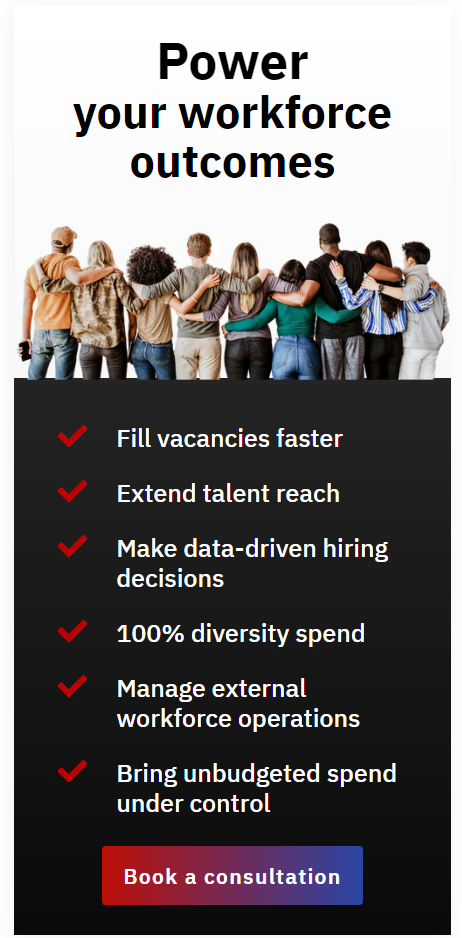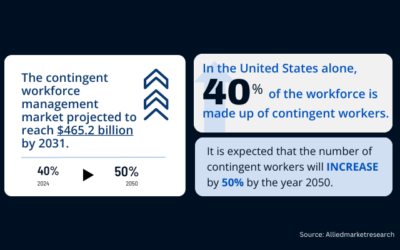5 ways COVID-19 has shaped the future extended workforce
1. Remote working used to be something only contractors and contingent workers did. That isn’t the case anymore.
The pandemic resulted in most employees working from home. It’s created a seed change in the aspirations of workers. According to a 2020 study by IBM, 61% of workers want to work from home for good.
Firms have reacted to this attitudinal shift in workers. Companies are revisiting their workforce and workplace strategies, with many very much linking the two together. A 2020 study by Gartner found that 82 percent of business leaders plan to let employees work from home at least sometimes and almost half plan to offer remote work permanently.
2. Through the work from home experience, employers have seen that localized pay premiums won’t work moving forward
Companies serious about remote working have to gear up—or at the very least ‘align’—their operational behaviors and technology to support it. One of the stars of remote working is the tech company Automattic, who offer a playbook on how they do remote working. Like many firms serious about home working, they have set out their agenda to frame remote working to support their 1000+ employees as a long-term solution.
One task companies unfamiliar with sustained remote working will have to do is sort out their pay scales, particularly the localized premium. In a TechCrunch interview, founder of Automattic Matt Mullenweg states, “We aim to pay the same rates for the same roles, regardless of geography. Automattic employs people in over 75 countries. Sometimes this puts us above or below what may be the market rate for a role in a given area.”
Basecamp’s approach is to pay all employees a competitive San Francisco salary rate even though they are remote working. “San Francisco was our benchmark because it’s the highest in the world for technology and because we could afford it, after carefully growing a profitable software business for 15 years,” said founder David Heinemeier Hansson.
The commitment of firms to find a new way of working was underlined by Mark Zuckerberg last year through his announcement of permanent remote work for Facebook employees. “We’ll localize everybody’s compensation on January 1.”
3. Employers won’t want to go back to office working because it would fly in the face of the productivity imperative
With workforce costs remaining the biggest operational cost for most companies, competitive success and growth has become woven into the ability of organizations to maximize worker productivity. A 2020 survey polled 206 corporate executives across a wide range of industries and found 83% of respondents look to workforce productivity to improve margin and profitability.
Interpreting productivity performance isn’t easy. In fact, the same survey reported that, while 5% use a standard, quantitative score to measure productivity across their company, most either rely on instinct (32%) or don’t measure productivity at all (19%).
While many execs have sought to look the other way, it’s been known for some time that working in pyjamas is good for productivity and the company bank balance. A study published in Harvard Business Review (HBR) as far back as 2014 from the founders of Ctrip sited a productivity boost of tele-workers of 13.5% more calls and economies of $2,500 per employee.
4. Employers have learned that you can’t run a flexible, hybrid workforce without digital ecosystems
It’s not about one or one hundred apps anymore. The time when company departmental managers could run off and invest in a boatload of SaaS apps and string them together, without any great consideration to data security, privacy and governance is fast disappearing.
It was BlackBerry founder Mike Lazaridis who coined the idea of a ‘super app’, describing it as “a closed ecosystem of many apps that people would use every day because they offer such a seamless, integrated, contextualized, and efficient experience.”
Businesses today are seeking to develop digital ecosystems to deliver ‘last mile’ self-service support for customers while automating their back office. In an always-on connected digital age it’s the only way to be competitive. The World Economic Forum estimates that “70% of new value created in the economy over the next decade will be based on digitally enabled platform business models.”
Finding, hiring, and supporting a flexible workforce through digital platforms has become a business-critical ingredient of enterprise success.
As Suresh Gupta, Chief Solution Architect for Simplify Workforce—a company that has developed a modern flexible workforce management platform for large enterprises—explains,
“Any business that wants to exist in the post-COVID era has to compete on labor rates and workforce productivity. Modern business has moved beyond the humble spreadsheet and internal database systems that only employees can access. Achieving optimal results requires a rich appreciation of talent sources, wage rates, productivity, and process effectiveness (etc.) that can only come from a joined-up digital ecosystem that serves all stakeholders be they buyer, supplier, contractor or intermediary.”
5. Along with virtual working has come an acceleration in levels of concerns over digital exhaustion and workforce wellbeing
Wellbeing of workers has become a major concern to workers and employers alike.
An Oracle survey into workforce mental health, published in early 2021, stated in its findings that, “Seventy percent of the global workforce say 2020 was the most stressful year ever.” A similar survey published by Microsoft found that a wide spectrum of age ranges were suffering from digital exhaustion. Working from home, equipped with a laptop and a mobile phone means, for many, there’s no letup on screen-time anymore for office meetings, workshops, trips to the canteen, or water-cooler moments.
FURTHER READING
Reducing Contingent Labor Costs: Strategies for Maximizing Efficiency
Discover how Workspend can help you reduce contingent labor costs and boost efficiency. Gain insights, implement strategic sourcing, optimize workforce planning, and ensure compliance. Partner with us for streamlined solutions. Contact us today!
Overcoming Executive Resistance: The Key to Successful MSP Program Implementation
Overcoming Executive Resistance: The Key to Successful MSP Program Implementation In today's dynamic business landscape, Managed Service Provider (MSP) programs have emerged as an indispensable tool for managing contingent labor effectively. However, transitioning...
3 Ways Analytics Drive Results in Contingent MSP Programs
Struggling to balance cost control with a growing contingent workforce? Many MSP programs turn ‘underwhelming’ after an encouraging start.




